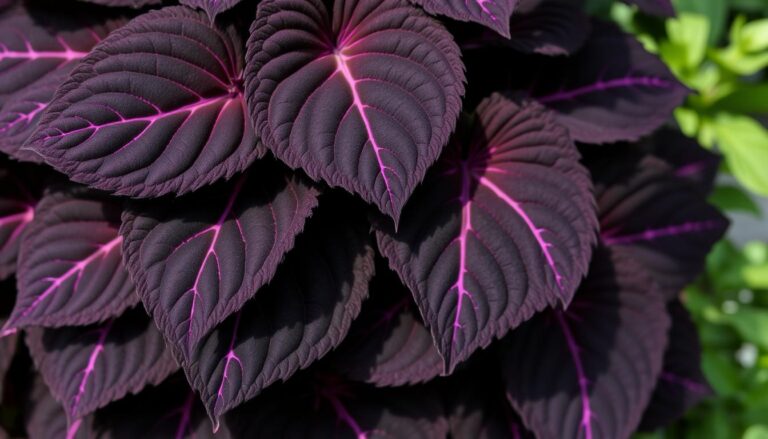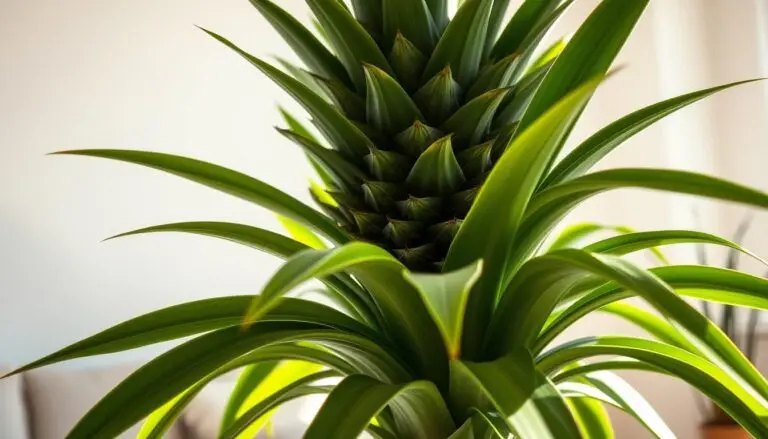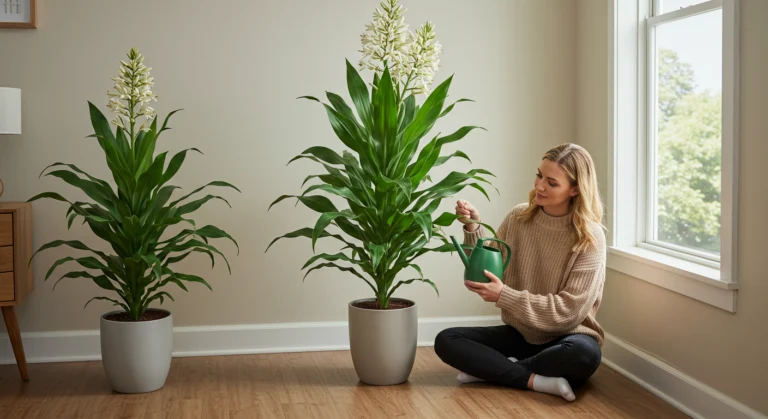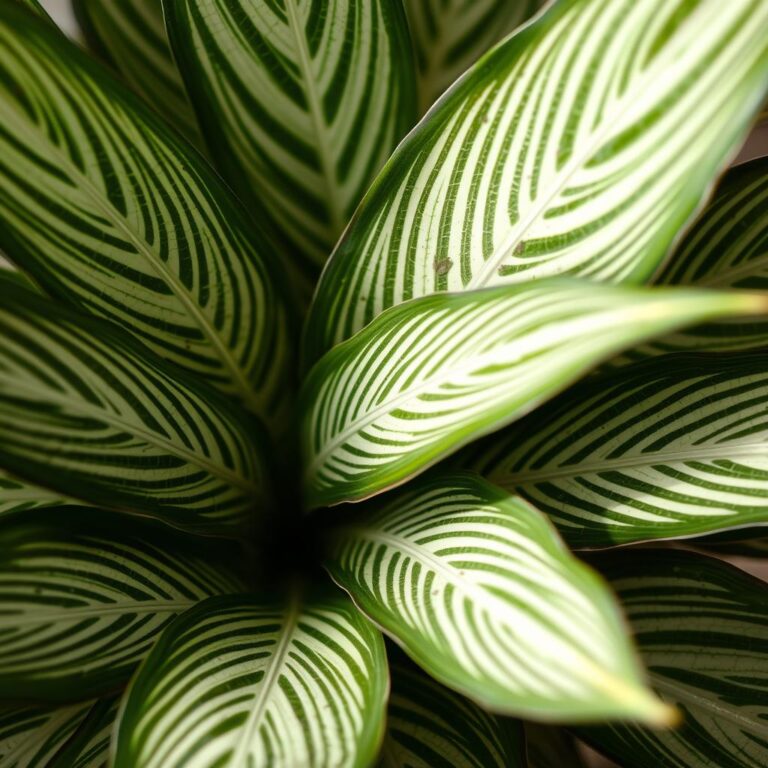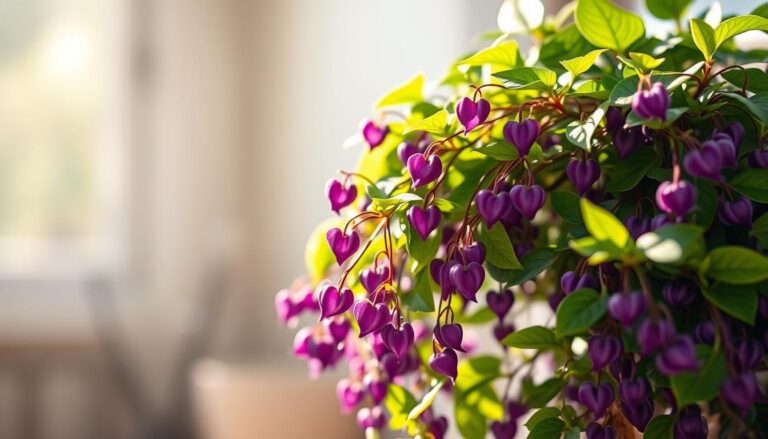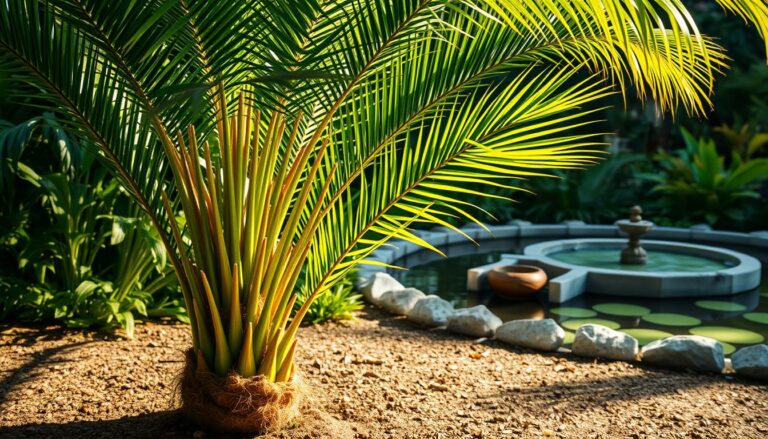how to care for a peace lily
There’s something magical about the peace lily. Its elegant white flowers and lush green leaves bring a sense of calm to any room. Beyond its beauty, this tropical plant is celebrated for its ability to purify the air, making it a favorite among houseplant enthusiasts.
Native to rainforests, the peace lily thrives in specific conditions. Understanding its needs is key to keeping it healthy. From proper soil to the right amount of water and light, every detail matters. This guide will walk you through everything you need to know to ensure your plant flourishes.
Whether you’re a seasoned gardener or a first-time plant owner, this step-by-step approach will help you create the perfect environment for your peace lily. Let’s dive in and unlock the secrets to its long-lasting beauty.
Table of Contents
Understanding Your Peace Lily
Originating from tropical rainforests, peace lilies are more than just decorative plants. These tropical plants thrive in the shaded understory of Central and South American forests. Their natural habitat offers dappled sunlight and high humidity, conditions that are key to their growth.
Despite their name, peace lilies are not true lilies. They belong to the Arum family, known for their unique white flowers and glossy leaves. Understanding their origins helps you recreate similar conditions indoors, ensuring your plant thrives.
Origins and Natural Habitat
Peace lilies are native to the tropical regions of Central and South America. They grow on forest floors, where they receive filtered light and consistent moisture. This environment provides the perfect balance of light and humidity for their growth.
To mimic their natural habitat, place your peace lily in a spot with bright, indirect light. Avoid direct sunlight, which can scorch the leaves. Maintaining high humidity levels is also crucial, especially in drier indoor environments.
Toxicity and Safety Considerations
While peace lilies are beautiful, they contain calcium oxalate, a compound that can be harmful if ingested. This makes them potentially toxic to pets and children. Symptoms of ingestion include mouth irritation, drooling, and difficulty swallowing.
To ensure safety, place your plant out of reach of curious pets and kids. If you suspect ingestion, contact a medical professional or veterinarian immediately. Despite this risk, peace lilies remain a popular choice for their air-purifying qualities and aesthetic appeal.
| Risk | Safety Tip |
|---|---|
| Ingestion by pets | Place the plant on high shelves or in hanging baskets. |
| Ingestion by children | Keep the plant in rooms children cannot access. |
| Skin irritation | Wear gloves when handling the plant or pruning its leaves. |
How to Care for a Peace Lily
Keeping your peace lily thriving requires attention to its basic needs. This tropical plant thrives with the right balance of water, light, and humidity. By following these guidelines, you can ensure your plant remains healthy and vibrant.
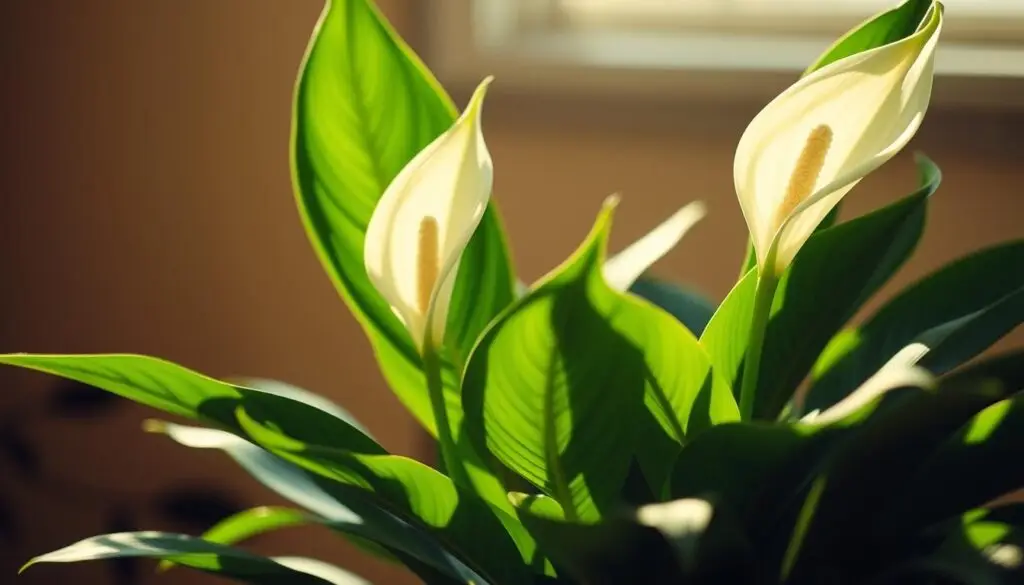
Watering and Light Requirements
Your peace lily prefers consistently moist soil. Water it when the top inch of soil feels dry. Use filtered, room-temperature water to avoid chemicals found in tap water. Overwatering can lead to yellow leaves, so ensure proper drainage.
Place your plant in bright, indirect light. An east- or north-facing window is ideal. Avoid direct sunlight, which can scorch the leaves. If the leaves start to droop, it’s a sign your peace lily needs water.
Fertilizing and Humidity Tips
During the growing season (spring and summer), feed your plant with a balanced houseplant fertilizer once a month. Dilute it to half strength to prevent over-fertilization. Avoid fertilizing in fall and winter when growth slows.
Boost indoor humidity by misting the leaves or using a pebble tray. Fill a saucer with pebbles and water, then place the pot on top. This mimics the tropical conditions your peace lily loves.
Planting, Repotting, and Propagating Techniques
Proper planting and repotting techniques are essential for a thriving peace lily. These steps ensure your plant has the right foundation for growth. From selecting the best soil to mastering propagation, each detail plays a vital role in its health.
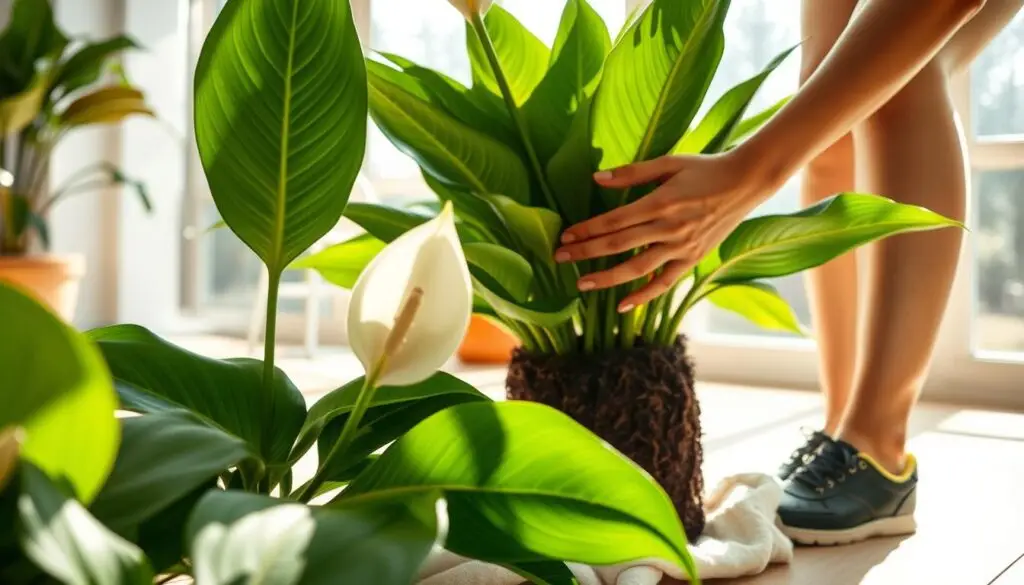
Choosing the Right Soil and Pot
Start with a well-draining, all-purpose potting mix. This type of soil retains moisture while preventing root rot. Avoid heavy mixes that can trap water and harm the plant.
Select a pot that’s twice the size of the root ball. Ensure it has drainage holes to prevent waterlogging. A larger container allows room for growth, keeping your peace lily healthy for years.
Repotting Best Practices
The best time to repot is in spring, during the active growing season. Gently remove the plant from its current pot, being careful not to damage the roots. Shake off excess soil and place it in the new container.
Fill the pot with fresh soil, ensuring the roots are well-covered. Water thoroughly to help the plant settle. Repotting every year or two keeps your peace lily vibrant and thriving.
Steps for Propagation Through Division
Propagation is simple with mature plants. Carefully divide the root ball into smaller clumps, ensuring each section has healthy roots and leaves. This process encourages new growth and expands your collection.
Plant each division in its own pot with fresh soil. Water lightly and place in a spot with bright, indirect light. With proper care, these new plants will flourish, bringing more beauty to your space.
Maintaining Optimal Conditions
Creating the perfect environment for your peace lily ensures its health and longevity. This tropical plant thrives in stable conditions, making it essential to monitor temperature and humidity levels. By maintaining these factors, you can enjoy vibrant flowers and lush foliage year-round.

Managing Temperature and Indoor Humidity
Your peace lily prefers temperatures between 65°F and 75°F. Avoid placing it near drafts, air conditioners, or heaters, as sudden changes can stress the plant. Consistent warmth mimics its natural habitat, promoting healthy growth.
Humidity is equally important. This houseplant thrives in moist air, so consider using a humidifier or placing it on a tray filled with water and pebbles. This setup increases moisture levels around the plant, preventing dry leaves and encouraging blooming.
Position your peace lily in rooms with stable heat, such as kitchens or bathrooms. These areas often have higher humidity, creating an ideal environment. Regularly check the surroundings to ensure no sudden fluctuations occur, as they can harm the plant.
Maintaining these conditions is key to the longevity and flowering of your peace lily. With proper attention, it will continue to bring beauty and calm to your space.
Troubleshooting Common Peace Lily Issues
Even the most resilient plants can face challenges, and your peace lily is no exception. Recognizing signs of distress early can save your houseplant from long-term damage. This section will guide you through identifying and resolving common problems.
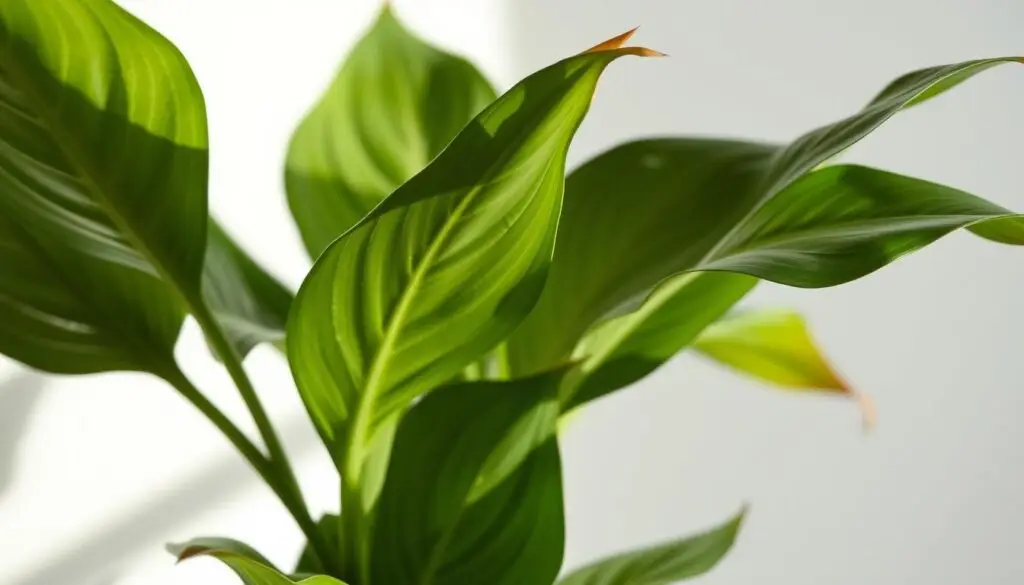
Identifying and Addressing Leaf Issues
Yellowing or browning leaves are common concerns. Overwatering is a frequent cause, leading to soggy soil and root suffocation. Check the top inch of soil before watering—if it’s damp, wait a few days.
Underwatering can also cause issues. Crispy brown tips and drooping leaves signal a need for more moisture. Adjust your watering schedule to keep the soil consistently moist but not waterlogged.
Low humidity often results in brown leaf tips. Increase moisture levels by misting the leaves or using a pebble tray. This mimics the tropical conditions your peace lily loves.
Preventing and Treating Pests and Diseases
Pests like mealybugs and spider mites can harm your plant. Look for webbing, sticky residue, or tiny insects on the leaves. Use insecticidal soap or neem oil to treat infestations naturally.
Root rot is another serious issue. Wilting leaves and a foul smell from the soil are key signs. Repot the plant in fresh, well-draining soil and trim affected roots to save it.
Regular inspections help catch problems early. Check the leaves, soil, and stems weekly for signs of pests or disease. Prompt action ensures your peace lily stays healthy and vibrant.
| Issue | Solution |
|---|---|
| Yellow leaves | Adjust watering schedule, ensure proper drainage. |
| Brown tips | Increase humidity, avoid direct sunlight. |
| Pest infestation | Use insecticidal soap or neem oil. |
| Root rot | Repot in fresh soil, trim damaged roots. |
Conclusion
Mastering the essentials ensures your peace lily remains vibrant and healthy. This tropical plant thrives with consistent moisture, bright indirect light, and stable humidity. By following these guidelines, you can create an environment where it flourishes.
Apply the step-by-step techniques to confidently maintain your plant throughout the year. Regular inspections help identify issues early, ensuring quick resolutions. From yellowing leaves to pest control, addressing problems promptly keeps your houseplant in top condition.
A thriving peace lily not only enhances your space but also purifies the air. Its lush foliage and elegant white flowers bring a touch of nature indoors. Start implementing these recommendations today to enjoy a healthy and beautiful plant.


